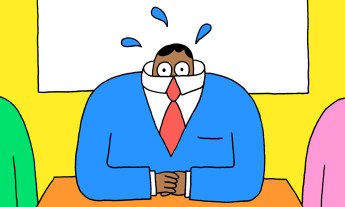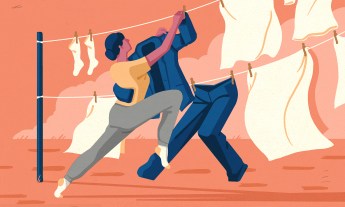
From comic books and radio programs to TV shows and Atari games, the world has always been full of things that distract us. Today most of us blame our phones or, more specifically, social media, Words with Friends, or Netflix as the reason we can’t get anything done.
Yet these aren’t the real culprit, according to technology expert Nir Eyal. Instead, our distraction is usually driven by our desire to escape discomfort, including boredom, fear and anxiety. When you binge on The Office rather than doing your taxes, watching Michael, Pam and Dwight is your (understandable) way of avoiding an activity you find tedious. The secret to staying focused at times like these is not to abstain from The Office — you’ll just find another distraction — but to change your perspective on the task itself. Below, Eyal explains how.
Ian Bogost studies fun for a living. A professor of interactive computing at the Georgia Institute of Technology, Bogost has written 10 books, including quirky titles like How to Talk About Videogames, The Geek’s Chihuahua, and, most recently, Play Anything. In the latter book, Bogost makes several bold claims that challenge how we think about fun and play. “Fun,” he writes, “turns out to be fun even if it doesn’t involve much (or any) enjoyment.”
Huh? Doesn’t fun have to feel good?
Not necessarily, Bogost says. By relinquishing our notions about what fun should feel like, we open ourselves up to seeing our daily activities in a new way. Play can be part of any difficult task, he believes, and though play doesn’t necessarily have to be pleasurable, it can free us from discomfort — which, let’s not forget, is the central ingredient driving distraction.
“Fun is the aftermath of deliberately manipulating a familiar situation in a new way,” says computing professor Ian Bogost.
Given what we know about our propensity for distraction when we’re uncomfortable, reimagining difficult work as fun could prove incredibly empowering. Imagine how powerful you’d feel if you were able to transform the hard, focused work you have to do into something that felt like play.
Is that even possible? Bogost thinks it is, but probably not in the way you think.
We’ve all heard Mary Poppins’s advice to add “a spoonful of sugar” and turn a job into a game — well, Bogost believes Poppins was wrong. He claims her approach “recommends covering over drudgery.” As he writes, “We fail to have fun because we don’t take things seriously enough, not because we take them so seriously that we’d have to cut their bitter taste with sugar. Fun is not a feeling so much as an exhaust produced when an operator can treat something with dignity.”
“Fun is the aftermath of deliberately manipulating a familiar situation in a new way,” Bogost says. The answer, therefore, is to focus on the task itself. Instead of running away from our pain or using rewards like prizes and treats to help motivate us, the idea is to pay such close attention that you find new challenges you didn’t see before. Those new challenges provide the novelty to engage our attention and maintain focus when tempted by distraction.
Operating under constraints, Bogost says, is the key to creativity and fun.
TV, social media, and other commercially produced distractions use slot machine-like variable rewards to keep us engaged with a constant stream of newness. Bogost points out that we can use the same techniques to make any task more pleasurable and compelling. He gives the example of mowing his lawn. “It may seem ridiculous to call an activity like this ‘fun,’” he writes, yet he learned to love it.
“Pay close, foolish, even absurd attention to things,” he says. Bogost soaked up as much information as he could about the way grass grows and how to treat it. Then, he created an “imaginary playground” in which the limitations actually helped to produce meaningful experiences. He learned about the constraints he had to operate under, including local weather conditions and what different kinds of equipment can and can’t do. Operating under constraints, Bogost says, is the key to creativity and fun. Finding the optimal path for the mower or beating a record time are other ways to create an imaginary playground.
While learning how to have fun cutting grass may seem like a stretch, people find fun in a wide range of activities that you might not find particularly interesting. Consider my local coffee-obsessed barista who spends a ridiculous amount of time refining the perfect brew, the car buff who toils for countless hours fine-tuning her ride, or the crafter who painstakingly produces intricate sweaters and quilts for everyone he knows. Of course, these people don’t find these activities tedious at all; to them, they’re the most fascinating and enthralling things in the entire world. But you can try bringing their mindset — their love of minutiae, their pride in mastery, their eternal yearning to do better — to some of your most dreaded tasks.
To use a popular aphorism, “The cure for boredom is curiosity. There is no cure for curiosity.”
For me, I learned to stay focused on the sometimes tedious work of writing books by finding the mystery in it. I write to answer interesting questions and discover novel solutions to old problems. To use a popular aphorism, “The cure for boredom is curiosity. There is no cure for curiosity.” Today, I write for the fun of it. Of course, it’s also my profession, but by finding the fun I’m able to do my work without getting as distracted as I once did.
Remember: Finding novelty is only possible when we give ourselves the time to focus intently on a task and look hard for the variability. The great thinkers and tinkerers of history made their discoveries because they were obsessed with the intoxicating draw of discovery, the mystery that pulls us in because we want to know more. Whether it’s uncertainty about our ability to do a task better or faster than last time or coming back to question the unknown day after day, the quest to solve these challenges is what can turn the discomfort we seek to escape into an activity we embrace.
Excerpted from the new book Indistractable: How to Control Your Attention and Choose Your Life by Nir Eyal. Copyright © 2019 Nir Eyal. Reprinted with the permission of Celadon Books, a division of Macmillan Publishing, LLC.
This post is part of TED’s “How to Be a Better Human” series, each of which contains a piece of helpful advice from someone in the TED community; browse through all the posts here.
Watch Nir Eyal’s TED Institute Talk now:














